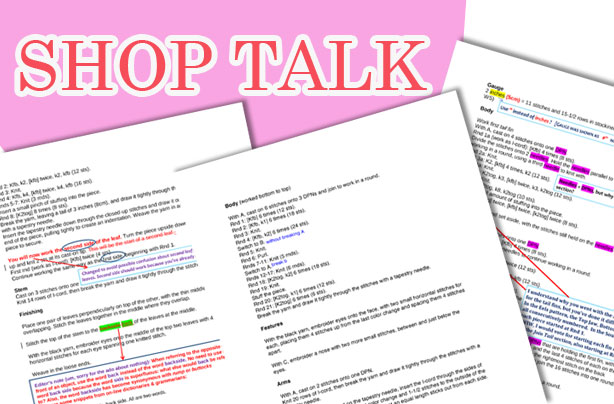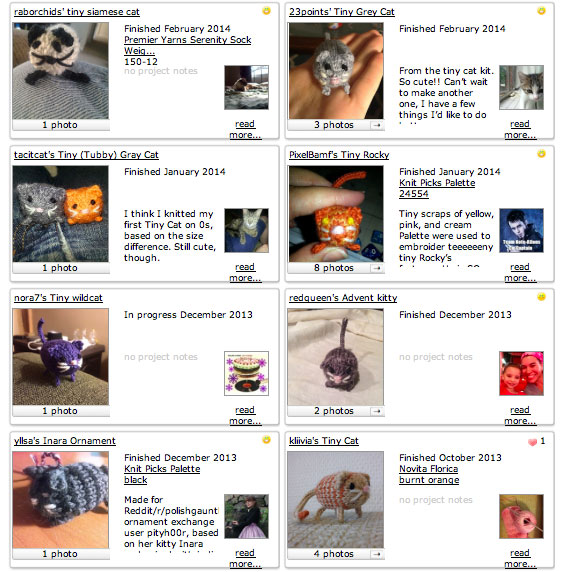In my last Shop Talk post, I did an overview of how I market a new pattern after I release it on my website. Today I’m going to take a couple steps back and talk about how I make sure that the pattern is as clear and user-friendly as possible with the help of some very important people: my testers and tech editor!

First, some definitions. A tech editor is someone who goes over a pattern closely, checking the stitch counts, row counts, measurements, and all the knitting language, correcting any errors or unclear wording along the way. A pattern tester is a knitter who tries out a pattern before it’s public to make sure it works like it’s supposed to.
If you ever visit the Designers group on Ravelry, you’ll see much discussion about these two roles, and which is more important. The short answer is that while you can certainly release a pattern without using either a tech editor or a tester (and I’ve certainly done this on occasion), if you want to make sure that the pattern is as good as it can be, both a tech editor and testers are a really good idea. But the way these two checking processes work is different for each designer.
My tech editing/testing process
I’ll admit that it’s only recently that I’ve started having all of my patterns tech edited. I know other designers would find that shameful! But my main two reasons were that my patterns don’t needed to be graded for different sizes/measurements and my testers were already fantastic about noticing errors and typos. However, my tech editor (a former tester) has done wonders for my patterns and now I wish I had started working with her earlier.
So now, when I have a close-to-final version of a pattern, with all the images included, I send it off to my tech editor first. We agree on a date by which she’ll send me her notes, usually a week or so from the time I send it to her. I’m sure all tech editors are different, but mine has a superhuman attention to detail, and she makes notes on even the tiniest bits of wording. I love this about her, even though it means that when I get a pattern back from her, it looks like it’s been in a knife fight! Once I receive this very red document, I go over all of the suggested changes, most of which I accept.
My tech editor’s contribution is more than just correcting numbers and punctuation—she questions wording that I’ve used for years with the goal of making it make better sense. In this process, it’s important for me to forget my ego for a bit and just take the feedback at face value. Sometimes that’s hard when I’ve already poured hours into pattern writing, but being open to another perspective is only going to make me a better designer.
After I’ve revised my pattern with my tech editor’s help, it’s time to send it to my testing pool. I keep this process simple: I have a list of about 40 testers, and I send an email to them all (using BCC) with details on the pattern (the size, the type of yarn and needles needed, the techniques involved), a photo of the finished project, and a deadline for sending feedback to me (usually 2 weeks out). The first 3 or 4 people who reply with interest will get the pattern to test. Testing means following the pattern as written and letting me know if they run into any questions, typos, or anything that seems unclear to them. I also request a photo of their finished project.
If a pattern requires a particularly large amount of yarn or some kind of special yarn that most people don’t have on hand, I do my best to send the testers yarn to work with. But for most tests, my testers can just use scraps from their stash—this makes perfect sense to me, as I think most people who use my patterns do the same anyway. It’s also interesting to me to see how a pattern turns out for someone using a really different type of yarn than the original design.
So testers provide me with a final-final check of a pattern, to make sure that everything in it “works” in another person’s hands. At this stage, I’m not anticipating making significant changes to a pattern, but sometimes a big change has to happen when multiple people have the same problems with one section. In that rare situation, I make the change (possibly re-knitting and re-photographing the toy), then I run it by my tech editor, and then find a couple of new testers to try out the revised version. All of that adds time to what’s already a long process, but taking some steps back at this point is better than having a sub-par pattern that hundreds of knitters will be frustrated with.
One more thing that testers do—they create finished projects! If they share their photos online at the time of a pattern’s release, other knitters can see that the results can be replicated. If you’ve ever searched for a pattern on Ravelry, you know that it’s a huge plus to see that multiple people have used it already and have created cool things!
Finding (and compensating) a tech editor and testers
From the Ravelry discussions that I’ve read, finding a good tech editor can be difficult, as they’re in high demand. I got lucky—my tech editor found me, and she happens to be one of the best. If you’re looking for a tech editor, a good place to start would be this thread in the Indy Pattern Designers group. (The discussion was started 6 years ago, but is still actively being posted on by people seeking tech editing work.) A good tech editor is not necessarily a prolific designer, but she or he should be extremely well versed in all types of knitting techniques and should have a good grasp of writing styles and abbreviations for knitting patterns. This is a professional position, and should be treated as such: references are a good idea! This is also work that should be paid for, and it’s a good investment that a designer should be willing to make.
What you should be looking for in test knitters is quite different: a test knitter should represent the average knitter out there, not a designer or someone particularly expert in pattern language. Myself, I try to maintain a pool with a mix of skill levels, although I do ask that my testers have some experience knitting toys, just so that they’re not completely lost with a pattern. Like my tech editor, most of my testers came to me, although sometimes I recruit testers from people who have contacted me about a problem that they’ve had with one of my patterns. If you’re looking for testers, a great place to start is the Testing Pool group on Ravelry. (By the way, I have all of the testers I need for now, but I’ll get the word out when I’m looking for more!)
You can make a great case for paying testers just like you would a tech editor, but for me, it’s important that my testers have the role of fan instead of employee. Everyone who tests patterns for me is doing so only because they wanted to be part of Team Mochimochi—I love that! And the many hours that my testers put into testing means that they would have to be paid very little for their work, and I’d rather that they enjoy the knitting in itself instead of being distracted by how much I’m nickel and diming them. That said, I send my testers another pattern of their choice once the test is finished, but I like to think of this as a “thank you” pattern rather than compensation for the work.
Final thought to this mostly image-barren post
My tech editor and testers do more than find errors in my patterns: they make me see my designs from a new perspective. They make suggestions about different techniques that I can incorporate (often introducing new techniques to me in the process), and they make me question the way I present those techniques. Even if I’m not going to make fundamental changes to a design once it’s in the tech editing/testing stage, I keep the feedback I receive in mind when I’m going forward with future designs. The whole point of writing a pattern is so that others can follow it, so it makes sense that it should take a team to develop that pattern. Go team!
Previous posts in this series:


I’d just wanted you to know I only started knitting after my aunt sent my grandmother your teeny-tiny mochimochi book. The patterns were so cute and original that I wanted to learn. I started with the dpn technique and learned almost everything through the help section in that book, since right around this time my grandmother had a stroke and couldn’t teach me. For me, your patterns are the most clear one’s I’ve ever used, and even now that I have zero problems with any of the techniques you use I find the photos of partially finished items helpful.
Keep up the good work. :)
Thank you Mariette—it’s so nice to hear that you find my patterns easy to follow! I’m sorry that your grandmother couldn’t pass on the craft directly to you, but it’s wonderful that you’ve taken it up in your own way.
Thank you for sharing this! I had often wondered how to find test knitters and a tech editor. I have really a notebook full of creatures that I have knit and made patterns for. On to the next step! Yay!
Very interesting, thank you for sharing. I’m fortunate in that a lot of my work is tech edited by the magazine that commissions the designs so I don’t require one very often. I don’t have time for test knitters due to tight deadlines but these would be handy to have sometimes. I do proof read my patterns including checking stitch counts before sending off the finished document so I can weed out errors at this point but I know this is not a perfect process.
Thank you for this valuable information! I hadn’t heard about tech-editors before—and that’s something I’ll definitely need…sometimes I’m just not so good at wording things so other people can understand them.. :) Thanks for the links!